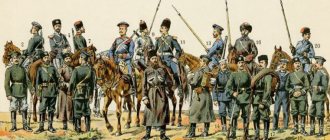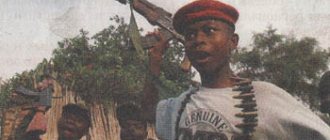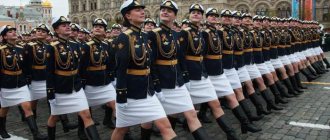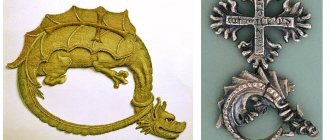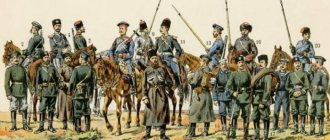Why does a vest need stripes?
Of course, many are interested in where the stripes came from, what their, perhaps, functional or symbolic purpose was. If you ask any Russian sailor, he will probably answer that the stripes on the vest mean the blue stripes of the St. Andrew's naval flag. Well, this version is quite working. But in other countries the naval flags were completely different, and the vest appeared in them long before Russia.
Another version is that the stripes represent sea waves. They say that the sailors, putting on a vest, wanted to show respect to the sea and merge with it with all their souls. It is possible that this is where the saying came from: the vest is the soul of a sailor.
Finally, a more scientific version says that initially the stripes on the vest were sewn by the Dutch sailors themselves onto a completely white undershirt. For purely practical reasons: so as not to blend in against the background of the white sails. The sailor, dressed in a vest, was clearly visible both on the deck and on the mast, and in the water.
It is curious that at first the sailors were punished for such self-will: after all, it seemed to the authorities that because of all these stripes, often crookedly and somehow sewn on, chaos and disorder reigned on board. But the sailor’s ingenuity won out - and, as they say, they came to terms with the vest.
New in blogs
History of the vest
There are many interesting holidays in Russia, including the birthday of the Russian vest, which is celebrated on August 19.
Although it is not yet official, it is very popular in our country.
It is especially widely celebrated in St. Petersburg, where enthusiasts celebrate it as their own tradition.
The “Amateur” decided to recall the history of this piece of clothing. Telnyashka (popularly also called telnik) is a striped shirt (hence the name), which is worn as a uniform item by military personnel in many countries, but only in Russia has it become a special symbol, a distinctive sign of real men.
The date August 19 was also not chosen by chance.
There is information that it was on this day in 1874, on the initiative of Grand Duke Konstantin Nikolayevich Romanov, who then held the highest naval rank - admiral general, Emperor Alexander II signed a decree on the introduction of a new uniform, which is the vest (a special “underwear” shirt) was introduced as part of the mandatory uniform for Russian sailors.
The emperor also approved the “Regulations on the allowance of the commands of the Naval Department in terms of ammunition and uniforms,” which stated that this uniform was intended for the “lower ranks of ships and naval crews” of the Russian fleet.
And the vest itself was regulated as follows: “A shirt knitted from wool in half with paper (ed. - with cotton); The color of the shirt is white with blue transverse stripes spaced one inch apart (44.45 mm).
The width of the blue stripes is a quarter of an inch... The weight of the shirt is supposed to be at least 80 spools (344 grams)...".
The blue and white transverse stripes of the vests matched the colors of the St. Andrew's flag, the official flag of the Russian navy. And it was assumed that the new part of the uniform would be comfortable and functional. The blue and white stripes of the vests corresponded to the colors of the St. Andrew's flag
Today it is popular not only among sailors.
It must be said that in general, vests as such are not a Russian “invention.” The prototypes of vests appeared during the heyday of the sailing fleet, around the beginning of the 18th century, and were “born by life itself.”
In the navy, it was very practical - it retains heat well, fits tightly to the body, does not restrict movement during any work, and dries quickly.
Moreover, from the very beginning, the vest was striped (although the stripes were colored, and the sailors themselves sewed them onto the shirt) - against the background of light sails, the sky and in the dark water, a man in a vest was visible from afar and clearly.
However, this approach resulted in an incredible variety of cuts, colors and stripes, so the “striped shirt” was considered a non-statutory form of clothing, and people were punished for wearing it.
Attitudes towards it changed in the middle of the 19th century, when the Dutch naval uniform of a short peacoat, flared trousers and a jacket with a deep neckline on the chest, into which the vest fit perfectly, came into fashion, and it was included in the sailor’s uniform.
In Russia, the “fashion” for vests began to take shape, according to some sources, since 1862, according to others - since 1866.
And the military reforms of 1865-1874 greatly changed the appearance of the Russian armed forces, and Russian sailors began to wear Dutch uniforms, including a vest. In the mid-19th century, the Dutch naval uniform came into fashion
As a result, by decree of Alexander II in 1874, it was legalized as part of the uniform of a Russian sailor.
Moreover, at first, vests were issued only to participants in long-distance hikes, and they were very proud of and cherished.
In addition, they were first purchased abroad, and only then production was established in Russia.
Mass manufacturing of vests first began at the Kersten factory in St. Petersburg (after the revolution - the Red Banner factory).
Moreover, initially the white stripes were much (4 times) wider than the blue ones.
Only in 1912 did they become the same in width (a quarter of an inch - approximately 11 mm). At the same time, the material also changed - the vest began to be made from cotton and wool.
But the color of the stripes remained unchanged - white and dark blue.
After the revolution of 1917, the vest did not lose its popularity at all; wearing it was still prestigious.
But in Soviet times, in addition to white and blue vests, new “color solutions” appeared.
For example, the marines and rivermen wore vests with black stripes, and when the uniform for the Airborne Forces was created in 1969, by analogy with the uniform of sailors, vests were included in the uniform of the paratroopers, but the color of the stripes was changed to sky blue.
As a result, in the 1990s, vests with stripes of different colors were developed and officially “approved” for other branches of the military: black (naval submarine forces and marines), green (border troops), maroon (special forces of the Ministry of Internal Affairs), cornflower blue (FSB special forces, Presidential Regiment), orange (EMERCOM).
Sailors of all generations of the Russian fleet call the vest the “sea soul.” The naval vest is also included in the uniform of cadets of naval and civil sea and river educational institutions.
However, it was the white and blue vest that was destined to become not only the “favorite” of the sailors, but also their symbol of valor and brotherhood.
Sailors of all generations of the Russian fleet call it the “sea soul” and wear it with pleasure not only in the fleet, but also in everyday life.
Moreover, these clothes are popular not only among professionals, but also among ordinary people - both adults and children. It has long become not only an element of naval equipment, but also an item of clothing for many people not associated with the navy.
For example, a well-known popularizer of this “striped shirt” is the French fashion designer Jean-Paul Gaultier, who presented several blue-and-white striped ready-to-wear collections in the 1990s. Interesting facts: It is believed that a sailor who goes to the open sea for the first time (no matter on a fishing boat, merchant ship or military cruiser) immediately joins the brotherhood of brave conquerors of the sea elements.
There are a lot of dangers there, and sailors are the most superstitious people in the world. And one of the main maritime beliefs is associated with dark and light stripes applied to the vest.
It turns out that, unlike land citizens, every real sailor is sure that the abyss is inhabited by various demons and mermaids, and each of them poses a serious danger to the conquerors of the seas and oceans.
To deceive them, they used a vest: it was believed that, having put on such a shirt, the sailors seemed to the spirits of the sea to already be dead, of whom only skeletons remained.
Fishermen of French Brittany were the first to wear a robe with black and white stripes to protect themselves from the spirits of the sea.
At the beginning of the 17th century, this superstition spread throughout the Old World. Having put on a vest, the sailors seemed already dead to the spirits of the sea.
Starting from 1852, according to the French standard, the vest was required to have 21 stripes - according to the number of major victories of Napoleon.
In turn, the Dutch and English preferred a vest exclusively with 12 transverse stripes - the number of ribs in a person.
It is well known for what merits the vest migrated from the sea to land. The reason for this is the use of sailors in land military operations during the Civil and Great Patriotic Wars.
For some reason unknown to historians, the sailors turned out to be better fighters than their land counterparts. No wonder the enemy called the Marines “striped devils” in fear.
There is still a popular saying in Russia: “We are few, but we are wearing vests!”
During the war, it was supplemented by another: “One sailor is a sailor, two sailors are a platoon, three sailors are a company.”
In the first battle on land on June 25, 1941, near Liepaja, the Baltic sailors put to flight the Wehrmacht soldiers who had previously captured half of Europe.
It is worth noting two facts in the history of the Russian vest: the width of the white and blue stripes began to be the same size only in 1912 - each a quarter of an inch, that is, about a centimeter.
At the same time, the composition of the vest fabric itself changed. Initially, it was a mixture - half was wool, half was cotton, and since 1912, Russian vests began to be made entirely of cotton. During the years of revolutionary Russia, when there was a shortage of paint, and the blue color was in short supply at that time, the first vests of the workers' and peasants' Red Fleet were simply old. The number of stripes depends on the size; only the width of the strips is determined - 10 mm each. And it is called that because it is a “underwear shirt”.
But the color of the stripes is different. The sailors have dark blue stripes, the Airborne Troops have blue stripes, the border troops have light green stripes...
Designations of colors on vests
The stripes on modern vests can be not only blue. For example:
- Vests with black stripes are worn by submariners and marines;
- Cornflower blue stripes on the vests of FSB special forces and soldiers of the Presidential Regiment;
- Border guards wear light green vests;
- And light blue ones are in the Airborne Forces;
- A maroon vest is part of the Ministry of Internal Affairs uniform;
- Orange is intended for the Ministry of Emergency Situations.
As you can see, the vest is far from being as simple as it might seem at first glance. And its story can hardly be considered finished.
What is guy?
In the navy, a guy is called a collar that is tied over the uniform. The real meaning of the word "geus" (from the Dutch geus - "flag") is a naval flag. The flag is raised daily on the bow of ships of the 1st and 2nd ranks during anchorage from 8 a.m. to sunset.
The history of the appearance of the guy is quite prosaic. In the Middle Ages in Europe, men wore long hair or wigs, and sailors wore their hair in ponytails and braids. To protect against lice, hair was smeared with tar. To prevent tar from staining their clothes, the sailors covered their shoulders and back with a protective leather collar, which could be easily wiped clean from dirt.
Over time, the leather collar was replaced with a fabric one. Long hairstyles are a thing of the past, but the tradition of wearing a collar remains. In addition, after the abolition of wigs, a square cloth collar was used for insulation - in cold windy weather it was tucked under clothes.
A little history
In 1978, Soviet army personnel received maroon headdresses for the first time. Which troops were allowed to wear red berets is a question of interest to many, so it should be said that this was the privilege of the special forces of the Ministry of Internal Affairs. Initially, they were attached to the uniform of the Dzerzhinsky division, an elite unit based in the capital and the Moscow region. The products matched the color of the shoulder straps. General Sidorov approved the idea. By his order, the first berets with this shade were sewn at one of the textile enterprises.
Until 1987, they were allowed to be worn in demonstration classes. Officers of the Internal Troops wore berets on public holidays. Exactly a year later, the father of a member of the Dzerzhinsky division made an unexpected gift to his son and his colleagues - 113 hats, which were sewn from maroon cloth. This was exactly the number of staff of the company. With the unofficial approval of the leadership, units wore them over the next six months for any occasion.
Then another tradition was introduced. It was invented by company commander Lysyuk and his deputy after reading the book “Alpha Team” by former American special forces soldier Miklos Szabo. It talked about the training of the Green Berets. It was separately emphasized that in US special forces everything must be earned. You could get a beret by passing difficult exams.
For the purpose of professional growth of their wards and improvement of their training, an examination program was developed. Those who passed it automatically became representatives of the elite of the Russian special forces. The first exams were actually held underground, hiding them under the guise of regular training. Moreover, granting the right to wear a special forces beret only to those who passed the exam did not find support from the leadership. The command advocated that this should be a distinctive feature of the uniform of military personnel of any level of training.
The official document appeared in 1993. The commander of the VV, General Kulikov, approved the Regulations on these tests. Only members of the special forces of the Internal Troops were allowed to see it. In 1995, an order of the Ministry of Internal Affairs appeared on the uniform of employees and military personnel of the Internal Troops. This document secured the right to wear a maroon beret, its variety, for special forces. Starting next year, riot police, SOBR, and GUIN began taking the exam. Test conditions varied with an emphasis on the tasks that a specific unit must solve.
In 2005, the President signs Decree No. 531, dedicated to military uniforms. It notes that warrant officers and military officers wear a cap with maroon piping. Three years later, the Ministry of Internal Affairs issued an order regulating all tests for wearing headgear. The procedure for taking the exam is being finalized. Since then, speculation regarding the special forces symbol has become a thing of the past; questions and doubts no longer arise about who wears the red berets.
Not only Russia introduced maroon berets; similar headdresses are found in Belarus, Uzbekistan, Kazakhstan and Ukraine.
How was the “sea soul” born?
However, the vest became a cult a little later. After the Russo-Japanese War, demobilized sailors filled Russian cities. They were reminiscent of the residents of the New York Bronx, only instead of hip-hop they danced dances like “Yablochka”, talked about how they fought for Port Arthur, and looked for adventures on their own. The main attribute of these dashing sailors, the “soul wide open,” was the vest, which at that time began to be called the “sea soul.” It was at this time that the first mass acquaintance of the “sea soul” with the collective Russian soul took place. The union of “two lonely souls”, which occurred in 1917, gave a mixture that blew up Russia. The Bolsheviks, who actively used sailors in their seizure of power as a natural anti-system to any “land” order, in 1921, having suppressed the Kronstadt rebellion, finally rid themselves of the unwanted reflection of the “sea soul”.
Why is she striped?
Until recently, every cabin boy knew that the sea is inhabited not only by fish and aquatic creatures, but also by spirits. Lots of spirits! Establishing normal contact with them and finding mutual understanding is the key not only to a safe voyage, but also a guarantee of a sailor’s life expectancy. Mother destiny rules the sea directly, without the intermediary of “common sense.” In this regard, the main task of any person on the high seas is not to provoke fate to bad luck. Over many millennia, this goal has formed around itself a whole system of knowledge, a real science, which people dependent on the earth’s surface blithely call sea superstitions.
Sailors do not like to test axioms through personal experience. The experiments of physicists and the careless curiosity of lyricists are alien to him. All he has to do is strictly follow tradition, because it is difficult for drowned people to learn from their own mistakes.
Don't take a woman on a ship, don't whistle, don't kill seagulls, don't swim after crossing the equator; an earring in the ear so as not to drown, a tattoo so as not to become a ghost after death - everything carries its own specific meaning, where functionality is adjacent to mysticism and protective magic.
From time immemorial, Breton fishermen, when going to sea, wore striped (black and white) robes. It was believed that the robe protected them from the aggression of undines, mermaids and other evil spirits. Perhaps the Breton vest played the role of underwater camouflage, protecting from the gaze of sea demons. Or perhaps another function was attributed to the alternating horizontal stripes by Breton fishermen: one thing is for sure, the striped shirt played the role of a talisman.
During the period of the Great Geographical Discoveries, when there was an acute shortage of personnel in the world, many Breton fishermen joined the European fleets. But most of the Bretons, oddly enough, ended up on Dutch rather than French ships. Maybe because they paid well there, maybe because the Bretons didn’t really like the French usurpers, and maybe the Dutch, liberal by nature, did not forbid the Bretons from wearing their provocative striped outfits. It was the beginning of the 17th century; by the end of the century, the vest will become a global fashion trend for all European sailors.



